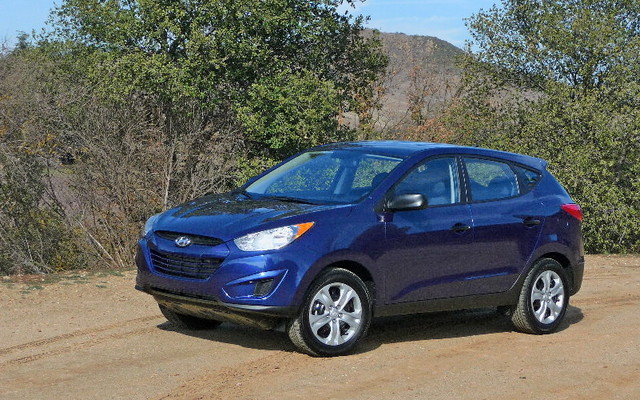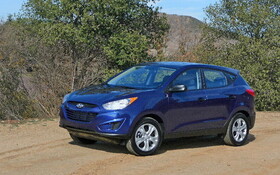The 2010 Hyundai Tucson: Following in the Santa Fe’s footsteps
Before we get into the new model itself, let’s back up a bit. Hyundai has only been in Canada for a quarter of a century and has progressed at an exponential rate for the last decade. If you look at the current models and compare them to the very first Pony, you’ll see a huge difference between then and now. Just as yesterday’s products were almost primitive, today’s models are among the most sophisticated on the market. For example, the first Santa Fe distinguished itself with its somewhat cartoonish original shape and rather inefficient all-wheel drive system, but it was sold at a very competitive price. When Hyundai tried again three or four years ago with a more modern version of the Santa Fe, it immediately set itself apart with its overall balance, worry-free handling and mechanical components that are as modern as what the competition is offering.
After launching the Santa Fe, Hyundai turned its attention to the compact utility vehicle category by unveiling the Tucson in 2004. Back then it was a simple, basic model that left its owners reasonably satisfied without having to break the bank. This is the second generation of the Tucson and the engineers and powers that be at Hyundai seem to have taken the same route that they took with the Santa Fe. Simply put, the Tucson can be considered a descendant of the Santa Fe. Hyundai uses the same recipe of balance, attention to detail, efficiency and simplicity. It remains to be seen if they have succeeded this time like they succeeded before with the intermediate model.
- Also: 2014 Hyundai Tucson
A fine figure
No offense to current Tucson owners, but this crossover’s design isn’t going to knock anyone’s socks off. It follows turn-of-the-century trends with good overall balance, but it’s more practical than elegant. However, times have changed, and Hyundai wants to be known for its style too. The new design philosophy, known as “fluid sculpture,” doesn’t mean much on paper but it makes for a very elegant vehicle. Indeed, it features a front end with an imposing grille crossed from one side to the other by a large band displaying the Hyundai logo. It also sports a plunging hood, wide fenders and wraparound elliptical headlights. All of this is accentuated by cradle-shaped fog lights and helps make the utility vehicle so elegant. I must also mention the raised tail end, taillights that wrap around the fender and the rear hatch – all of which give this new Korean a big presence on the road. We should also note that the window on the rear hatch is inclined toward the front while the lower part is rounded, which also contributes, along with a spoiler on the upper part of the roof, to its very dynamic shape. All in all, it’s a lot better than the previous version. Note that the new model is 7.5 cm longer, 2.5 cm wider and 28 kg lighter than its predecessor.
The first Tucson’s passenger compartment wasn’t the best, but it was still well balanced with simple ergonomics. This time, not only was emphasis placed on aesthetics but also on the quality of the materials, spaciousness and comfort. The stylists adopted a fashionable look with large buttons and a reasonably large LCD screen framed by two vertical air vents. It follows the current trend, but you’ll note that this central section bears an almost eerie resemblance to the Chevrolet Equinox. But this is subjective and it won’t stop you from liking it on the whole. By the way, the front seats have a very generous range of movement, and despite the fact that I’m almost 6’3”, I had trouble reaching the pedals when the seat was in the furthest position back. Take note, tall people. Although the two main indicator dials are easy to read, the same cannot be said for the small information centre between the two. Displaying the fuel level, the total kilometres and a trip odometer, its bluish lighting makes it hard to read in certain conditions. The rest is well laid out and easy to access.
Long live the four-cylinder engine!
My first surprise when this utility vehicle was unveiled at the Los Angeles International Auto Show was that it was only offered with one engine...and it was a four-cylinder to boot! But after reflecting for a few seconds, I concluded that the Korean manufacturer followed the current trend: that is, producing vehicles that are quite big, but that are lighter and feature four-cylinder engines that are more powerful and fuel efficient than the V6 engines that were previously used. Thus, the Tucson is powered by a 2.4-litre four-cylinder engine featuring 176 horsepower. Essentially, it has the same power and performances as the V6 engines that previously came with the Tucson. Moreover, fuel consumption is 20% lower than the old four-cylinder engine. This new engine is made entirely of aluminum and comes with the latest variable intake and exhaust valve timing technology.
This engine comes standard with a six-speed manual gearbox or the six-speed Shiftronic manumatic automatic gearbox on option. Of course, all-wheel drive with electronic control is available. What’s more, there’s a hill descent control that limits vehicle speed to 8 km/hr once the system activation button is pushed. The Tucson can also be equipped with a hill assist system that lets you remove your foot from the brake for two seconds and the vehicle will still remain immobilized. After two seconds, the system turns off all by itself. Finally, and still with the all-wheel drive, it’s possible to lock the central differential for a 50/50 split at speeds lower than 30 km/hr. There’s power steering to reduce fuel consumption and also simplify the mechanics, which makes it lighter.
Making the vehicle lighter is also the reason why the front and rear roll bars are hollow, although they are larger in diameter. It has independent front and rear suspensions. However, a multi-link rear suspension is now used to minimize the suspension columns intrusions in the baggage hold. As you can see, the engineers at Hyundai concentrated on the details to put the finishing touches on their Tucson. Oh, almost forgot...this is the first Hyundai model with a panoramic roof.
On the road
The Tucson quickly made us forget the previous model in every way. Indeed, it has better soundproofing, its body is more rigid, its suspension is well-calibrated and the steering even offers pretty decent feedback for an electrically driven power steering. I had the chance to drive both a manual and an automatic version. Those who are looking for a sportier driving experience with the standard transmission will be disappointed since it’s more utilitarian than anything else. It has well-selected gear ratios and shifting is about average, no more, no less. The friction point of the clutch was reasonably high. Basically, this gearbox gets the job done, but the Tucson is better with the six-speed automatic gearbox. The gearing is appropriate, it doesn’t hunt needlessly and its fuel consumption is better than with the manual gearbox that is offered with front-wheel drive models. The automatic averages 7.8 litres per 100 km compared to 8.3 litres for the manual. You can draw your own conclusions...
The engine was up to the task. The Tucson isn’t a speed demon, but its accelerations and pick-up are good for the category. As for handling, the vehicle is neutral in turns and I was surprised by how easily it took on the turns in a particularly winding stretch of road during our test drive at the launch. The continuously variable valve timing system is efficient and even in fifth gear with the manual version and climbing quite a steep incline, the engine never once made the sound of maracas that the valves usually make under these circumstances.
All things considered, the Tucson is just as well made as the previously unveiled Santa Fe. The price list had not yet been made public, but you can expect that the manufacturer will be very competitive in this regard. This model will be available in three versions: GL, GLS and GLS Limited.












